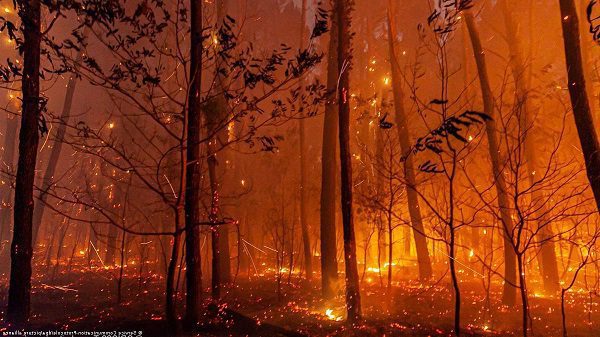Scorching Heatwaves and Raging Fires: Southern Europe is bracing for its second heat wave, which threatens public health and increases wildfire risk. After last week’s “Cerberus” heat wave, Italy, Spain, and Greece are experiencing a new heat wave named “Charon,” after the Greek mythological ferryman who takes souls to the underworld. The European Space Agency predicts a prolonged heat wave. Italy is particularly affected, with many cities expected to reach 40 degrees Celsius (104 degrees Fahrenheit).
Climate scientist Hannah Cloke from the University of Reading compares it to a giant oven hovering over the Mediterranean. Due to stable high-pressure conditions, African hot air has settled over southern Europe, heating the sea, land, and air. Residents struggle in this heat and wildfires are more likely.
Extreme heat is worldwide. As today is expected to be the hottest day on record in many parts of the world, World Health Organization head Tedros Adhanom Ghebreyesus urges world leaders to address the climate crisis. Northwestern China had a scorching 52.2 degrees Celsius (126 degrees Fahrenheit), while California’s Death Valley reached nearly 52 degrees Celsius (125.6 degrees Fahrenheit). These alarming temperatures underscore the urgency of action.
Scientists warn that heat waves will increase as the human-caused climate crisis worsens. Fossil fuels have raised the global average temperature by 1.2 degrees Celsius since pre-industrial times. Simon Lewis, chair of global change science at University College London, says the current warming trajectory, with an estimated 2.7 degrees Celsius (4.9 degrees Fahrenheit) increase by 2100, is terrifying. Preventing further warming requires urgent and sustained carbon emission reductions, but adapting to increasingly severe heatwaves is essential for humanity’s survival.
June 2023 had the highest ocean temperatures and lowest Antarctic ice levels ever. Christopher Hewitt, director of climate services at the World Meteorological Organization, said the following weeks saw unprecedented heat, plunging the planet into uncharted territory.
Extreme heat risks vulnerable populations. Chris Hilson, director of the University of Reading’s Centre for Climate and Justice, warns against dismissing heatwaves as summer vacation hassles. Heatwaves kill many, especially the elderly. Climate justice requires reducing CO2 emissions and adapting to extreme heat’s unequal effects. Cool zones, drop-in centers, greener neighborhoods, and renewable-powered air conditioning in care homes can reduce the negative effects.


READ MORE: Solar Maximum Surges: Sun Activity Peaks Sooner Than Expected
North African high-pressure anticyclones are raising temperatures in Italy, Greece, and Spain. Europe’s 2021 record of 48.8 degrees Celsius (118.4 degrees Fahrenheit) may be broken. Some regions of Italy will reach 45 degrees Celsius (113 degrees Fahrenheit) between Monday and Wednesday. The oppressive heat continues at night.
Italian authorities recommend staying hydrated, eating lighter meals, and avoiding direct sunlight between 11 a.m. and 6 p.m. The Acropolis in Athens was closed due to high temperatures. Spain, including Seville, Cordoba, and Granada, has scorching temperatures, with even northern Navarra reaching 40 degrees Celsius (104 degrees Fahrenheit).
Heatwaves increase wildfire risk. Fires have destroyed thousands of hectares on the Canary Islands, forcing residents to flee. Over 500 Greek firefighters are fighting four wildfires, evacuating a summer camp and nursing home. Two large wildfires near Athens are spreading quickly, forcing evacuations. A fire closed Sicily’s Catania airport until Wednesday.
Extreme heat events are becoming more frequent and intense. Society can reduce the unequal effects of extreme heat and secure a sustainable future by addressing the climate crisis, reducing carbon emissions, and implementing adaptive measures.
Our Reader’s Queries
Can heatwaves cause wildfires?
The mix of heat, aridity, and ignition sources forms an ideal setting for wildfires. Rapid Fire Spread: Intense temperatures and minimal humidity levels in heat waves can accelerate fire spread.
Can high temperatures cause fires?
Extreme heat is not solely responsible for sparking forest fires. It’s the deadly duo of scorching temperatures and extended dry spells that create the perfect conditions for fires to ignite more readily, particularly when there’s a source of ignition nearby. Dry plants and trees alone aren’t enough to burst into flames without human involvement.
How wildfires are caused by climate change?
Studies indicate that shifts in climate result in hotter, drier weather, which in turn prolongs and intensifies fire seasons. Rising temperatures and the dehydration of the atmosphere from human-related climate change have heightened the dryness of forest fuels during the period of wildfires.
How will heat wave affect hurricane season?
Warmer-than-usual oceans are essential for tropical storms and hurricanes to develop. A warmer atmosphere has the ability to hold more moisture, resulting in rainier storms that are more prone to causing flooding.

